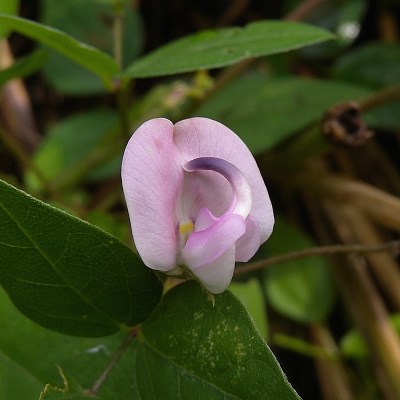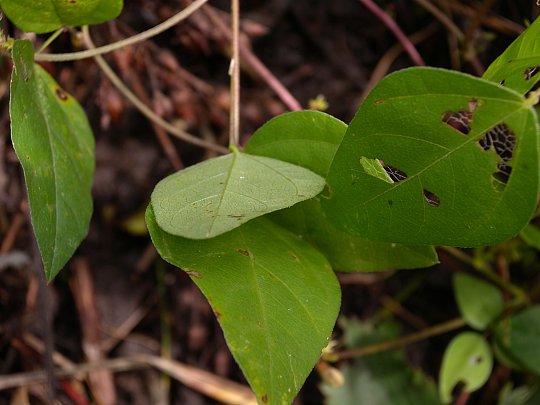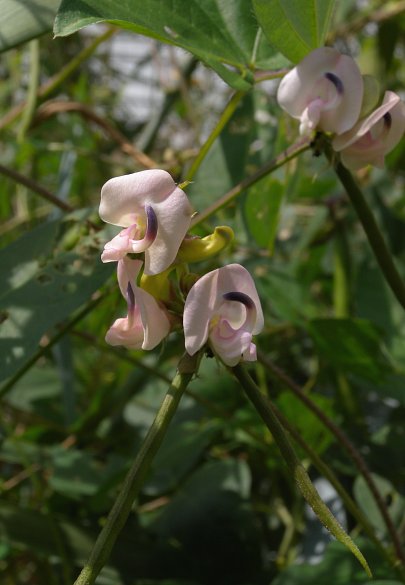Description: This plant is a trailing or climbing annual vine about 3-9' long that branches occasionally. The slender stems are light green, gray-green, or dull red, terete, and hairy; they can climb by twining around the stems or branches of neighboring plants. Alternate trifoliate leaves occur at intervals along the stems. The leaflets are 1-2" long and ½–1¼" across; the terminal leaflet is usually a little larger than the lateral leaflets. The leaflets are broadly lanceolate to ovate with well-rounded bases and smooth margins; the terminal leaflet has a short stalk at its base (petiolule), while the lateral leaflets are nearly sessile. For this variety of Strophostyles helvula, the leaflets lack obtuse basal lobes, unlike the typical variety. The upper leaflet surfaces are medium green and hairless (or nearly so), while their lowers surfaces are pale green and hairless (or nearly so). The slender petioles of the trifoliate leaves are about 1-2" long; they are usually slightly pubescent. At the base of each petiole, there is a pair of tiny linear-lanceolate stipules.

At the axils of some leaves, there develops individual stalks (peduncles) of flowers; these stalks are 3-6" long. At the apex of each stalk, there is a dense cluster of 3-10 nearly sessile flowers; usually only 1-2 flowers are in bloom at the same time. Each flower is about 1/3" long or a little more, its petals consisting of a large rounded banner, a pair of slender lateral petals, and a narrow keel that is curled upward. These petals are light pink to pink, fading to white or pale green; at the bottom of the banner, there is a small patch of yellow. At the base of each flower, there is a short tubular calyx with 5 teeth; this calyx is sparsely hairy. At the base of each calyx, there are lanceolate tiny bracts with pointed tips that are about the same length as the calyx. The blooming period occurs from mid-summer to early fall and lasts about 2 months. Each fertile flower is replaced by a cylindrical seedpod that is 2–3½" long at maturity. The seedpod is initially green, but later becomes dark brown; it is nearly glabrous to sparsely hairy. Individual seeds are about ¼" long, oblongoid in shape, and pubescent. Each seedpod eventually divides into two parts to disperse the seeds.

Cultivation:
The
preference is partial sun, moist to mesic conditions, and soil
containing sand, loam, silt, or gravelly soil. The root system can fix
nitrogen in the soil.
Range & Habitat:
This native wildflower is occasional throughout Illinois (see Distribution
Map);
the map
does not differentiate between var. missouriensis
and the typical variety, Strophostyles helvula helvula
(Trailing Fuzzy Bean). Missouri Fuzzy Bean is less common than the
typical variety and it is found primarily in counties along the
Mississippi River. Habitats of both varieties include open woodlands
(including sandy and rocky woodlands), thickets and sandy thickets,
riverbanks, sand bars and gravel bars along rivers, abandoned fields,
and areas along railroads. Habitats with some history of disturbance
are preferred.

Faunal
Associations:
The flowers are cross-pollinated by bees, especially Large Leaf-Cutting
bees (Megachile spp.) and bumblebees. One bee species, Megachile
integra, is a specialist pollinator (oligolege) of Strophostyles
spp. (Fuzzy Beans). Both nectar and pollen are available as
floral rewards. Missouri Fuzzy Bean also has extra-floral nectaries,
which attract primarily wasps, flies, ants, and small Halictid bees.
The extra-floral nectaries may prevent nectar thieves (e.g., ants) from
stealing nectar from the flowers, or they may attract insects (e.g.,
ants & wasps) that help to protect the plant from insects that
feed on the foliage. Insect feeders of the foliage include the
caterpillars of Thorybes bathyllus (Southern
Cloudywing), Epargyreus clarus (Silver-Spotted
Skipper), and Urbanus proteus (Long-Tailed
Skipper). The leaf beetles Cerotoma trifurcata and Sumitrosis
ancoroides also feed on the foliage. The seeds are eaten by
such birds as the Wild Turkey, Bobwhite, and Mourning Dove, while the
foliage is readily consumed by cattle, deer, and probably other
mammalian herbivores.
Photographic Location:
The wildflower garden of the webmaster in Urbana, Illinois.

Comments: Missouri Fuzzy Bean is one of several species in the Fabaceae (Bean family) that are vines. It has fairly typical pea-like flowers for species in this family, except that the keels of the flowers curl upward in an odd manner. Another distinctive characteristic of Strophostyles spp. (Fuzzy Beans) is the production of dense clusters of flowers on long stalks (although only a few flowers bloom at the same time per cluster). The common name 'Fuzzy Bean' refers to the hairiness of the seedpods and/or the pubescent seeds of many species in this genus. As already mentioned, Missouri Fuzzy Bean differs from the typical variety, Strophostyles helvula helvula (Trailing Fuzzy Bean), by the lack of obtuse basal lobes on its leaflets. Because of this characteristic, Missouri Fuzzy Bean can be difficult to distinguish from Strophostyles umbellata (Perennial Fuzzy Bean), which has similar leaflets. For Missouri Fuzzy Bean, the tiny bracts at the base of each flower are about as long as the calyx and they have pointed tips. In contrast, the tiny bracts of Perennial Fuzzy Bean are only one-half as long as the calyx and they have blunt tips. Another species, Strophostyles leiosperma (Small Fuzzy Bean), has smaller leaves and flowers, while the calyx of each flower is densely hairy. Sometimes the scientific name Strophostyles helvula is spelled 'Strophostyles helvola,' which is apparently incorrect.